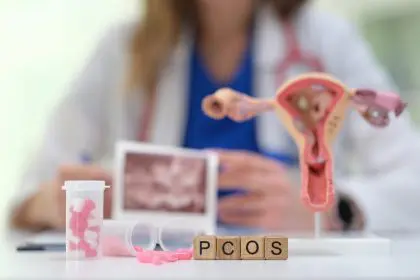Endometriosis affects approximately 10% of women worldwide, causing debilitating pain when tissue similar to the uterine lining grows outside the uterus. While medical treatments remain essential, growing evidence suggests dietary modifications can substantially impact symptom severity. Strategic food choices targeting inflammation reduction and hormonal balance offer promising complementary approaches for the millions suffering from this condition.
The endometriosis-inflammation connection
Endometriosis develops when endometrial-like tissue implants outside the uterus, commonly on the ovaries, fallopian tubes, and tissue lining the pelvis. Unlike normal endometrial tissue that sheds monthly, these abnormal growths remain trapped, causing inflammation, scarring, and often intense pain. Estrogen fuels this inflammatory process, stimulating tissue growth and triggering immune responses that amplify discomfort.
The condition manifests through several challenging symptoms including severe menstrual cramps, chronic pelvic pain, painful intercourse, excessive bleeding, and in some cases, fertility complications. This symptom profile significantly impacts quality of life, affecting everything from work productivity to intimate relationships.
While conventional treatments focus on hormonal interventions and surgical management, nutrition represents an often-overlooked aspect of comprehensive care. Research increasingly suggests that dietary choices directly influence the inflammatory processes and hormonal balances that drive endometriosis progression and symptom severity.
Foods that intensify endometriosis symptoms
Before exploring beneficial foods, understanding which items may worsen symptoms proves equally important. Several food categories demonstrate potential to exacerbate endometriosis-related inflammation and discomfort:
- Red meat consumption correlates with increased endometriosis risk and symptom severity in multiple studies. The high content of arachidonic acid in red meat promotes inflammatory pathways that can intensify pain and tissue growth. Additionally, conventionally raised meat may contain hormonal residues that potentially disrupt endogenous hormone balance.
- Gluten-containing grains trigger inflammatory responses in many women with endometriosis, even those without celiac disease. Research indicates that approximately 75% of women with endometriosis experience improvement in pain scores after eliminating gluten. This connection likely stems from gluten’s ability to promote intestinal inflammation that subsequently affects systemic inflammatory markers.
- Trans fats and processed foods rich in omega-6 fatty acids shift the body toward pro-inflammatory states. Fast food, commercially baked goods, and many packaged snacks contain these problematic fats that can amplify existing inflammation. The Western dietary pattern high in these foods correlates with increased endometriosis severity in observational studies.
- Alcohol consumption increases estrogen levels through multiple mechanisms, potentially feeding endometrial tissue growth. Even moderate intake can impair liver function responsible for estrogen clearance, allowing this hormone to circulate longer and intensify symptoms.
- High-FODMAP foods cause digestive distress through fermentation in the intestines, creating bloating and discomfort that can compound endometriosis-related pain. Common high-FODMAP foods include certain fruits (apples, pears), vegetables (onions, garlic), and wheat-based products.
Fiber-rich foods that support hormone balance
The first category of beneficial foods centers on fiber-rich options that help eliminate excess estrogen from the body. Dietary fiber binds to estrogen in the digestive tract, facilitating its removal through stool rather than reabsorption into circulation. This process, called estrogen sequestration, helps maintain healthier hormone levels that may reduce endometrial tissue stimulation.
Cruciferous vegetables including broccoli, cauliflower, Brussels sprouts and kale offer dual benefits. Beyond their high fiber content, these vegetables contain compounds called indole-3-carbinol and diindolylmethane that support healthy estrogen metabolism. Regular consumption correlates with reduced inflammation markers and improved symptoms in women with estrogen-dependent conditions.
Research indicates that consuming at least 1-2 servings of cruciferous vegetables daily provides measurable benefits for hormonal health. These vegetables can be lightly steamed to preserve their beneficial compounds while improving digestibility for sensitive individuals.
Legumes including lentils, chickpeas, black beans and peas deliver substantial fiber alongside plant-based protein. One cup of cooked lentils provides approximately 15 grams of fiber—over half the daily recommendation for women. This fiber content supports healthy digestion and estrogen elimination while their protein content helps stabilize blood sugar, potentially reducing inflammation.
Studies show that women consuming legumes regularly experience better hormonal balance and reduced inflammatory markers compared to those following typical Western diets. Incorporating legumes into soups, salads and grain bowls provides sustainable symptom management benefits.
Anti-inflammatory omega-3 powerhouses
The second category focuses on foods rich in omega-3 fatty acids, which directly counteract inflammatory processes. These beneficial fats influence the production of prostaglandins and cytokines that regulate pain perception and inflammatory responses throughout the body.
Fatty fish including salmon, mackerel, sardines and herring provide the most bioavailable forms of omega-3 fatty acids: eicosapentaenoic acid (EPA) and docosahexaenoic acid (DHA). These compounds directly compete with inflammatory omega-6 fatty acids in cellular membranes, shifting the body toward an anti-inflammatory state.
Research demonstrates that women consuming at least two servings of fatty fish weekly report significantly lower pelvic pain scores compared to non-fish eaters. The protective effect appears dose-dependent, with greater benefits observed with more frequent consumption.
Walnuts and flaxseeds contain the plant-based omega-3 fatty acid alpha-linolenic acid (ALA). While less potent than fish-derived omega-3s, these foods still offer substantial anti-inflammatory benefits, particularly for those following plant-based diets. One ounce of walnuts provides 2.5 grams of ALA, supporting improved pain management when consumed regularly.
Flaxseeds offer the additional benefit of lignans—compounds that modulate estrogen activity in the body. Studies suggest that consuming 2 tablespoons of ground flaxseed daily may help reduce estrogen-dominant conditions through both anti-inflammatory and hormonal mechanisms.
Nutrient-dense foods addressing specific deficiencies
Endometriosis frequently leads to nutritional challenges, particularly iron deficiency due to heavy menstrual bleeding. Addressing these deficiencies through targeted food choices supports overall health and symptom management.
Dark leafy greens like spinach, kale and Swiss chard provide iron alongside folate, magnesium and numerous antioxidants. These nutrients support healthy red blood cell production, muscle relaxation and cellular protection against oxidative stress. The combination proves particularly beneficial for counteracting fatigue and muscle cramps associated with endometriosis.
Research indicates that women consuming at least one serving of dark leafy greens daily demonstrate improved energy levels and reduced pain scores compared to those with lower intake. For optimal iron absorption, pairing these foods with vitamin C sources like citrus fruits or bell peppers enhances benefits.
Colorful berries provide concentrated sources of polyphenols and anthocyanins—powerful antioxidants that neutralize free radicals and reduce inflammatory signaling. Blueberries, strawberries, raspberries and blackberries all demonstrate impressive antioxidant capacity that helps protect tissues from inflammatory damage.
Multiple studies show that daily berry consumption correlates with reduced levels of inflammatory markers in the bloodstream. Approximately one cup daily appears sufficient to observe measurable benefits for inflammatory conditions including endometriosis.
Specialized foods with targeted benefits
Beyond the broader categories above, certain foods contain specific compounds with unique benefits for endometriosis management.
Turmeric contains curcumin, a compound with remarkable anti-inflammatory properties comparable to some pharmaceutical interventions. Curcumin inhibits nuclear factor-kappa B (NF-κB), a protein complex that regulates inflammatory gene expression extensively involved in endometriosis progression.
Research demonstrates that regular turmeric consumption reduces inflammatory markers and pain scores in women with endometriosis. The addition of black pepper significantly enhances curcumin absorption—combining ¼ teaspoon turmeric with a pinch of black pepper in daily meals provides therapeutic benefits.
Green tea contains epigallocatechin gallate (EGCG), a catechin with demonstrated ability to inhibit endometrial cell proliferation and migration in laboratory studies. This compound appears to work through multiple mechanisms, including antioxidant protection, anti-inflammatory effects, and modulation of estrogen activity.
Clinical studies suggest that consuming 2-3 cups of green tea daily may help reduce endometriosis progression and symptom severity. The moderate caffeine content additionally helps with pain management through separate mechanisms.
Fermented foods including yogurt, kefir, sauerkraut and kimchi support gut microbiome health, which directly influences estrogen metabolism and inflammatory processes. These foods provide beneficial probiotic bacteria that help maintain intestinal barrier function, preventing bacterial components from triggering systemic inflammation.
Research indicates that women consuming fermented foods regularly demonstrate improved estrogen metabolism and reduced inflammatory markers. Including at least one serving of naturally fermented foods daily supports this gut-hormone connection.
Implementing dietary changes effectively
While incorporating these beneficial foods offers significant potential for symptom relief, implementation requires thoughtful strategy. Rather than attempting dramatic overnight changes, gradual incorporation of beneficial foods while slowly reducing problematic ones typically yields more sustainable results.
Starting with an anti-inflammatory foundation emphasizing whole, minimally processed foods creates the basis for symptom management. From this foundation, specific eliminations can help identify personal triggers, some women find certain foods impact their symptoms more significantly than others.
Tracking symptoms alongside dietary intake helps identify patterns and personalize approaches. Many women notice cyclical changes in food sensitivities corresponding with their menstrual cycle, requiring adaptive strategies throughout the month.
For those seeking more structured approaches, several dietary patterns show promise for endometriosis management. The Mediterranean diet, with its emphasis on plant foods, olive oil, fish and minimal processed food, demonstrates significant benefits for inflammatory conditions including endometriosis. Similarly, a modified low-FODMAP approach helps many women reduce digestive symptoms that compound endometriosis discomfort.
While dietary changes cannot cure endometriosis, they represent a powerful tool for symptom management and potentially slowing disease progression. When combined with appropriate medical care, nutritional strategies empower women to take active roles in managing this challenging condition, improving quality of life and daily functioning.

















